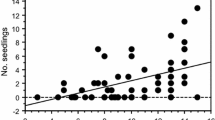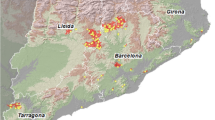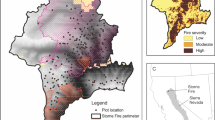Abstract
This study aims to develop a series of robust and efficient methodologies, which can be applied to understand and estimate firebrand generation and to evaluate firebrand showers close to a fire front. A field scale high intensity prescribed fire was conducted in the New Jersey Pine Barrens in March 2013. Vegetation was characterised with field and remotely sensed data, fire spread and intensity was characterised and meteorological conditions were monitored before and during the burn. Firebrands were collected from different locations in the forest and analysed for mass and size distribution. The majority were found to be bark slices (more than 70%) with substantial amounts of pine and shrub twigs. Shrub layer consumption was evaluated to supplement the firebrand generation study. Bark consumption was studied by measuring the circumference variation at several heights on each of three different pine trees. The variation was in the same order of magnitude as the bark thickness (1–5 mm). Testing and improving the protocol can facilitate the collection of compatible data in a wide range of ecosystems and fire environments, aiding in the development of solutions to prevent structural ignition at the Wildland Urban Interface.














Similar content being viewed by others
References
National Interagency Coordination Center (2013) Wildland Fire Summary and Statistics, Annual Report. http://www.nifc.gov/fireInfo/nfn.htm.
Foote EID, Liu J, Manzello SL (2011) Characterizing firebrand exposure during wildland urban interface fires. Proceedings of Fire and Materials Conference
Maranghides A, Mell W (2013) Framework for Addressing the National Wildland Urban Interface Fire Problem - Determining Fire and Ember Exposure Zones Using a WUI Hazard Scale. .
4. Hammer RB, Radeloff VC, Fried JS, Stewart SI (2007) Wildland-urban interface housing growth during the 1990s in California, Oregon, and Washington. International Journal of Wildland Fire 16 :255–265.
5. Flannigan MD, Stocks BJ, Wotton BM (2000) Climate change and forest fires. Science of The Total Environment 262 :221–229.
Cohen JD (2000) What is the wildland fire threat to homes? In: Thompson Memorial Lecture, April 10, 2000 School of Forestry, Northern Arizona University, Flagstaff, AZ. http://www.fs.fed.us/rm/pubs_other/rmrs_2000_cohen_j003.pdf.
7. Manzello SL, Foote EID (2014) Characterizing Firebrand Exposure from Wildland–Urban Interface (WUI) Fires: Results from the 2007 Angora Fire. Fire Technology 50 :105–124. doi:10.1007/s10694-012-0295-4.
8. Koo E, Pagni PJ, Weise DR, Woycheese JP (2010) Firebrands and spotting ignition in large-scale fires. International Journal of Wildland Fire 19 :818–843.
9. Viegas DX, Almeida M, Raposo J, et al. (2014) Ignition of Mediterranean Fuel Beds by Several Types of Firebrands. Fire Technology 50:61–77. doi:10.1007/s10694-012-0267-8
10. Tarifa CS, DelNotario PP, Moreno FG (1965) On the flight paths and lifetimes of burning particles of wood. Tenth International Symposium on Combustion. The Combustion Institute, Cambridge, UK, pp 102–1037
Albini FA (1979) Spot fire distance from burning trees–a predictive model. General Technical Report INT-56 73p.
12. Albini FA (1983) Transport of Firebrands by Line Thermals. Combustion Science and Technology 32:277–288.
13. Tse SD, Fernandez-Pello AC (1998) On the flight paths of metal particles and embers generated by power lines in high winds - a potential source of wildland fires. Fire Safety Journal 30 :333–356.
Woycheese J. (2000) Brand lofting and propagation from large-scale fires. PhD thesis. University of California – Berkeley
Rissel S, Ridenour K (2013) Ember Production During the Bastrop Complex Fire. Fire Mananagement Today 72:
16. Manzello SL, Cleary TG, Shields JR, Yang JC (2006) Ignition of mulch and grasses by firebrands in wildlandurban interface fires. International Journal of Wildland Fire 15:427–431. doi:10.1071/WF06031
17. Manzello SL, Cleary TG, Shields JR, Yang JC (2006) On the ignition of fuel beds by firebrands. Fire and Materials 30:77–87. doi:10.1002/fam.901
18. Manzello SL, Maranghides A, Mell WE (2007) Firebrand generation from burning vegetation. International Journal of Wildland Fire 16:458–462. doi:10.1071/WF06079
Vodvarka V (1969) Firebrand field studies – Final report. Report no. IITRI-J6148. Chicago
20. Manzello SL, Shields JR, Cleary TG, et al. (2008) On the development and characterization of a firebrand generator. Fire Safety Journal 43 :258–268.
21. Manzello SL, Suzuki S, Hayashi Y (2012) Enabling the study of structure vulnerabilities to ignition from wind driven firebrand showers: A summary of experimental results. Fire Safety Journal 54 :181–196.
Mueller E, Skowronski N, Simeoni A, et al. (2013) Fuel Treatment Effectiveness in Reducing Wildfire Intensity and Spread Rate – An Experimental Review. 4th Fire Behavior and Fuels Conference
23. Skowronski NS, Clark KL, Duveneck M, Hom J (2011) Three-dimensional canopy fuel loading predicted using upward and downward sensing LiDAR systems. Remote Sensing of Environment 115:703–714. doi:10.1016/j.rse.2010.10.012
McKeown D, Faulring J, Krzaczek R, et al. (2011) Demonstration of delivery of orthoimagery in real time for local emergency response. In: Shen SS, Lewis PE (eds) Algorithms and Technologies for Multispectral, Hyperspectral, and Ultraspectral Imagery XVII. p 80480G–80480G–11
Clark K, Skowronski N, Gallagher M, et al. (2013) Assessment of Canopy Fuel Loading Across a Heterogeneous Landscape Using LiDAR.
26. Johnson EA, Miyanishi K (2001) Forest Fires. Academic Press, San Diego, pp 585–594
27. Manzello SL, Cleary TG, Shields JR, et al. (2008) Experimental investigation of firebrands: generation and ignition of fuel beds. Fire Safety Journal 43 :226–233.
28. Suzuki S, Manzello SL, Lage M, Laing G (2012) Firebrand generation data obtained from a full-scale structure burn. International Journal of Wildland Fire 21:961. doi:10.1071/WF11133
29. Hughes JB (1987) New Jersey, April 1963: Can it happen again? Fire Management Notes 48:3–6.
30. Manzello SL, Park S-H, Cleary TG (2010) Development of rapidly deployable instrumentation packages for data acquisition in wildland–urban interface (WUI) fires. Fire Safety Journal 45:327–336. doi:10.1016/j.firesaf.2010.06.005
Byram GM (1959) Combustion of forest fuels. In: Davis, K.P., ed. Forest fire: control and use. New York McGraw Hill 61–89.
32. Alexander ME (1982) Erratum: Calculating and interpreting forest fire intensities. Canadian Journal of Botany 60:2185–2185. doi:10.1139/b82-267
33. Morandini F, Silvani X (2010) Experimental Investigation of the Physical Mechanisms Governing the Spread of Fire. International Journal of Wildland Fire 19 :570–582.
Mueller E, Skowronski N, Clark K, et al. (2014) An experimental approach to the evaluation of prescribed fire behavior. Advances in forest fire research. doi: http://dx.doi.org/10.14195/978-989-26-0884-6_4
Acknowledgments
Authors thank the New Jersey Forest Fire Service. The field experiment was supported by the Joint Fire Science Program (Project 12-1-03-11). Dr. Filkov was supported by the Fulbright program of Institute of International Education, the Government Assignment in the Field of Scientific Activity (Number 1624) and by the President of the Russian Federation Scholarship (Number SP-3968.2013.1).
Author information
Authors and Affiliations
Corresponding author
Rights and permissions
About this article
Cite this article
El Houssami, M., Mueller, E., Filkov, A. et al. Experimental Procedures Characterising Firebrand Generation in Wildland Fires. Fire Technol 52, 731–751 (2016). https://doi.org/10.1007/s10694-015-0492-z
Received:
Accepted:
Published:
Issue Date:
DOI: https://doi.org/10.1007/s10694-015-0492-z




